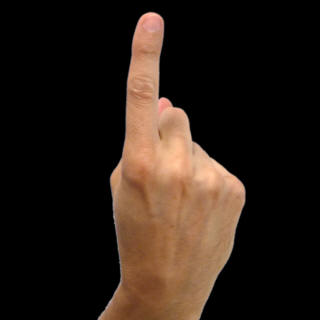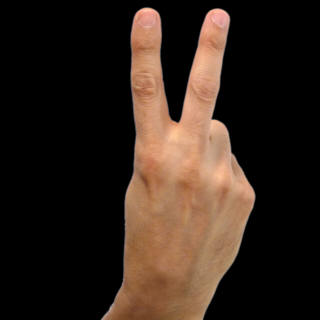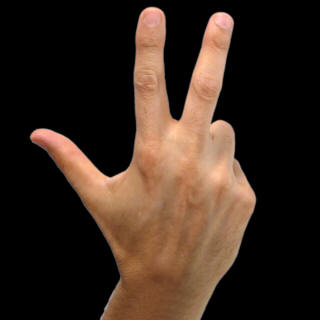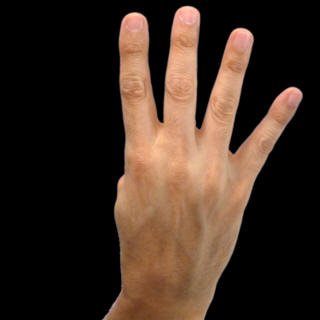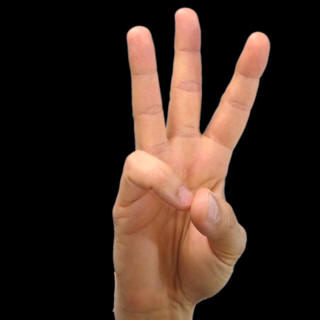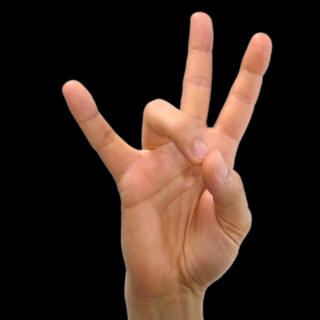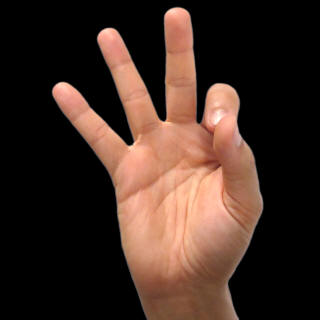ASL Numbers Discussion
Also see http://asl.bz
LINKS: Numbers 1-10 / 11-20 / 21-30 / 31-40 / 41-99 / 100-900 / 1000 and up / Fractions / Numbers Chart
Below you will find a collection of various information regarding signing numbers in ASL. To see examples of the number signs, visit the links above.
Numbers Discussion:
Bill's first rule of doing numbers: If it hurts, don't do it.
Your hand should be held in a comfortable position.
Try this: Lift your hand into the air in front of your torso.
Don't worry about trying to point your hand "exactly" straight ahead or straight back.
Just adjust your palm orientation until you feel the least stress and the most comfort. Find that "comfortable position." Now you are ready to start doing your numbers.If you are taking a sign language class from an in-person instructor who prefers you do the numbers a certain way, by all means follow the guidance of your local instructor! The version(s) I show you on this website are (in general) very good versions. Your local instructor however should be familiar with any local versions that might be more appropriate for your area. Or if you notice the Deaf people in your area tending to do it one way or the other, follow their lead.
In the pages here I'll be sharing with you some specific rules for how to do the numbers.
For example, "When done in isolation, numbers 1 through 5 are generally done palm back."
Try to stay flexible though because there are often exceptions to those rules.
For example in I just told you that "When done in isolation, numbers 1 through 5 are generally done palm back." (Which is to say, the palm of your hand is facing back toward you.") However if those numbers are part of a series (such as a phone number) they are instead done palm forward.
Thus it depends on the circumstances.
I once watched Randal King, an excellent native signer give an example of circumstances when numbers and "day signs" (such as Monday, Tuesday, etc.) might be done palm forward. He roleplayed (kidding around) an "arrogant" individual and signed a phrase to a pretend employee. He told the "employee" that he wanted the employee finish a report and turn it in - "and I want it on Monday!!!" The last two signs in his sentence were, WANT MONDAY!!! As Randal signed Monday, he extended his arm outward toward the person he was signing to and did the sign MONDAY palm forward (instead of palm back) using a strong motion and strong facial expression.
Thus we see that some signs that are normally done palm back (or up) are occasionally done palm forward for emphasis.
I might do the sign for "3" palm forward to someone if for some reason I wanted to emphasize the number.However, exceptions are exactly that, "exceptions." Stick with the general rules but stay flexible.
Questions and answers:
Daniel: Do I read the pictures right? Is the sign for "2" and the sign for "V" the same?
DrVicars: Yes, 2 and "V" are the same. In normal conversation though, it is never a problem. For example, my name: "Vicars," you wouldn't misunderstand that as "2icars." Context generally makes it clear. In some situations it might be more difficult.
Suppose you were fingerspelling your screen name to someone and it had some numbers mixed in with the letters.
One way to deal with "look-alikes" is to sign the letter palm forward and the number palm back. (As in the case of the number "2" and the letter "v."
Another way is to use internal motion in the number. For example -- the number "6." You can tap the pinkie on the thumb a couple times and it is obvious it is a six not a "w." The number "9" you can tap the tip of the index finger on the thumb.
A third way is to do the letters normally, but place the numbers up against the palm of the non-dominant hand.Sharp: I found it difficult to sign the letter F am I trying to straighten the fingers too much?
DrVicars: I only straighten the pinkie and ring fingers when doing an "F" or "9." I let the middle bend half-way. Does that help?
Sharp: Thanks.
See: Numbers 1-10
Advanced number discussion:
DrVicars: When you sign numbers, you do them quite similar to the way they are said in English. For example: If you are signing "1997," you sign "19" then "97."
If you do a phone number, just do it as you would say it. I leave a small pause where the hyphen would be so the watcher can write the first part (if they are writing it down), before I do the second part.
Years:
You'll still see a bit of variety for the years 2000 - 2009. Most people do the individual numbers while sliding the hand slightly to the right. For example showing a two-zero-zero-zero for the year 2000.
The number 2009 is two-zero-zero-nine all in one smooth movement sliding slightly to the ourside.
You may see variations, but that is the way I recommend you sign the years 2000-2009. I have on occasion observed a few of my friends using the "thousand" sign as part of the sign for years 2000 and up, but I don't recommend you use the "thousand" sign for "years."
Numbering for Lefties:
For lefties: Most numbers are either signed without sideward movement or with only a very slight movement further to the left. (Again, I'm discussing how left handed people do numbers. I know someone is going to "miss that" and run around saying that Dr. V said such and such. Wake up.)
For example: The number "57" is commonly held in place as it changes from a "5" into a "7." For lefties it would also be okay to use a very small leftward movement as you change from a 5 to a 7--but why waste energy?
For Lefties: Double numbers: 22, 33, 44, 55, ... start palm forward and a bit downward (45% angle), slap downward, come up and move to the left in a small arc (toward the outside) and slap downward again.
Numbering for Lefties:
Numbers 21, 24, 26, 27, 28, 29:
Start with an "L" handshape and move slightly to the left (or simply "do in place" without moving to the left) and then do the next digit. For example, "24" would look like "L4"
Notes: The number 21 tends to move the thumb twice, for example "L1L1" and/or hold it pointing somewhat forward at an angle as if shooting a gun (the thumb looking somewhat like the hammer of a pistol coming down twice). It is also common to instead move the index finger as if "pulling a trigger" twice.
General notes:
The number 23 uses a palm-forward "3 handshape" and wiggles the middle finger downward a couple times.
The number 25 uses a palm-forward "5 handshape" and wiggles the middle finger downward a couple times.The numbers 6-9 are palm forward.16 - 19 use a palm back (or side) to palm forward twist.
The numbers 30 on up are palm forward.
The repeated digits like 33, 44, 55, etc. are palm forward but slap downward twice.
111 - 113 start palm forward and turn backward for the second part of the sign.
